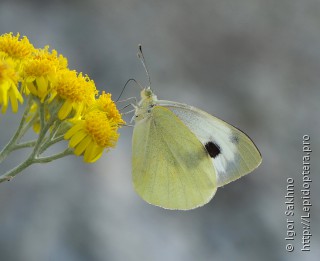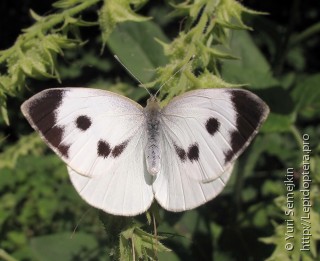Pieris brassicae (Linnaeus, 1758)

Taxonomy
class Insecta → subclass Pterygota → infraclass Neoptera → superorder Holometabola → order Lepidoptera → superfamily Papilionoidea → family Pieridae → subfamily Pierinae → tribe Pierini → genus Pieris → subgenus Pieris → species Pieris brassicae
Species name(s)
Pieris (Pieris) brassicae (Linnaeus, 1758) = Papilio brassicae Linnaeus, 1758 = Pontia chariclea Stephens, 1827 = Ganoris wollastoni Butler, 1886 = Pieris brassicae (Linnaeus, 1758). [9, 10, 355]
Large White, The Large Cabbage White.
urn:lsid:insecta.pro:taxonomy:8840
Expansion
This species marks on the maps: 7.
Zoogeographical regions
Palaearctic, Indo-Malayan.
Russia regions
#1. Kaliningradsky; #2. Kolsky; #3. Karelsky; #4. Evropeisky Severo-Zapadny; #6. Evropeisky Severo-Vostochny; #7. Evropeisky yuzhno-tayozhny; #8. Evropeisky Tsentralny; #9. Evropeisky Tsentralno-Chernozyomny; #10. Sredne-Volzhsky; #11. Volgo-Donsky; #12. Nizhnevolzhsky; #13. Zapadno-Kavkazsky; #14. Vostochno-Kavkazsky; #15. Severo-Uralsky; #16. Sredne-Uralsky; #17. Yuzhno-Uralsky; #19. Sredneobsky; #20. Yuzhno-Zapadnosibirsky; #22. Krasnoyarsky; #23. Predaltaisky; #24. Gorno-Altaisky; #25. Tuvinsky; #26. Predbaikalsky; #27. Pribaikalsky; #28. Zabaikalsky; #36. Sredne-Amursky; #37. Nizhne-Amursky; #38. Sakhalin; #40. Primorsky.
Forewing length
30—33 mm.
Wingspan
55—70 mm.
Primary colors
Yellow, Brown/Gray/Black, White.
Flight time
| January | February | March | April | May | June | July | August | September | October | November | December |
Larva lifespan
| January | February | March | April | May | June | July | August | September | October | November | December |

Detailed information with references
Distribution
- Albania, Austria, Belgium, Bulgaria, Great Britain, Hungary, Germany, Denmark, Greece, Ireland, Iceland, Spain, Italy, Corsica, Crete, Luxembourg, Malta, Netherlands, Norway, Poland, Portugal, Romania, Sardinia, Sicily, Slovakia, Turkey - European part, Finland, France, Czech Republic, Switzerland, Sweden, Estonia, Yugoslavia. [1].
- Austria, Azores, Albania, Andorra, Balearic Islands, Belarus, Belgium, Bulgaria, Bosnia and Herzegovina, the British Isles, France, Germany, Gibraltar, Greece (mainland), Denmark (mainland), Dodecanese Islands, Iceland, Ireland, Spain (mainland), Italy (mainland), Cyprus, Corsica, Crete,Latvia, Liechtenstein, Lithuania, Luxembourg, Madeira, Macedonia, Malta, Monaco, Netherlands, Norway (mainland), the Channel Islands, Poland, Portugal (mainland), Romania, Russia, Sardinia, Northern Ireland, Northern Aegean Islands, Sicily, Slovakia, Slovenia, Turkey (European part), Ukraine, Finland,France (mainland), Croatia, Cycladic, Czech Republic, Switzerland, Sweden, Estonia, Yugoslavia. [10].
- Regions of the Russian Federation: the Volga-Don, East Caucasus, Gorno-Altaisk, the European North-East, the European North-West, the European Central Black Earth, the European Central European South taiga, Transbaikalia, Western Caucasus, Kaliningrad, Karelia, Kola, Krasnoyarsk, Nizhne-Amur, Lower Volga,Prealtay, of Baikal, Pribaikalskiy, Primorye, Sakhalin, the North Urals, Mid-Amur, the Volga-Average, Average Urals, Sredneobskaya, Tuva, South West Siberian, South Ural. [3].
- Distribution in Thailand: Wiang Pa Pao, Doi Ang Klang [144].
- Вид распространен в Европе до 62° с. ш., но на севере реже, чем на юге. Кроме того — Урал, юг Сибири, Южное Приморье и Сахалин, Северная Африка и даже Индия от Гималаев до долины Ганга. В 70-х годах ХХ века завезен в Чили. [85].
Imago Habitus and Differences from alike species
- Wingspan 45-60 mm. Male, UP is white, with black apex on FW, and a black spot at apex of HW. Female is slightly broader, with broader marking at FW apex, two additional discal spots and a black streak at mid-dorsum of FW; UN are similar in both sexes, white with black spots on FW and yellowish without markings on HW. [144].
- Длина переднего крыла достигает 3,3 см. На вершинах передних крыльев темные поля, у самок кроме того еще и 2 черные пятна на каждом переднем крыле и булавовидное пятно — на заднем. У самцов по одному черному пятну только на каждом из задних крыльев. Кроме того, половые различия хорошо видны на исподе, который у самок желтоватый (особенно яркий желтый цвет у бабочек второго поколения). [85].
General info about Imago
- Типичный и самый известный представитель белянок. Капустницу можно встретить повсюду — в естественных биотопах (луга, опушки лесов), в больших городах и близ прочих населенных пунктов, в полях, садах и прочих сельхозугодьях. В горах доходит до 2000 м (в Алтае — до 1700).
Иногда наблюдаются массовое размножение этой бабочки, причем основная масса капустниц появляется во втором и третьем поколениях. Было вермя, когда капустная белянка не встречалась столь часто, но после того, как человек начал массово культивировать капусту, для гусениц капустниц началась совсем другая жизнь. Впрочем, естественные враги этих бабочек (например, наездник Apanteles glomeratus, куколки в желтых коконах которого можно наблюдать на гусенице Pieris brassicae и гриб Entomophtora sphaerosperma) размножаются вслед за бабочками, поэтому практически никогда не бывает двух сезонов подряд, в течение которых капустница могла бы сильно размножиться. [85].
Imago lifespan
- 2—3 поколения. 1-е поколение летает с середины апреля до начала июня, 2-е — с середины июля до конца августа и 3-е, которое бывает далеко не каждый год — с сентября по октябрь. [85].
General info about Larva
- Взрослая гусеница капустницы синевато-зеленого цвета, с черными пятнами различной величины и желтыми продольными полосками на боках и спине (одной желтой полосой на спине и желтоватым низом — Коршунов, 2002), живет 3—4 недели и линяет за это время 4—5 раз. Сразу после рождения гусеницы держатся вместе (взрослые гусеницы живут поодиночке), выгрызают срединные части листа и только спустя какое-то время начинают объедать края, в результате от листа могут остаться одни лишь жилки. [85].
Larva food plants / other food objects
- Brassica oleracea [144].
- Of the cruciferous species, P. brassicae caterpillars prefer cabbage (Brassica), bedbug (Lepidium), mustard (Sinapis), in particular field mustard (Sinapsis arvensis), radish (Raphanus), for example, field radish (Rhapanus rhapanistrum), asp (Rorippa) and others, and of the mignonette-yellow mignonette (Reseda lutea). Second-generation caterpillars are particularly susceptible to cultivated plants such as turnips (Brassica rapa) and cabbage. [85].
Larva lifespan
- Гусеница: 1-е поколение: август—октябрь, 2-е поколение: июнь—июль, 3-е поколение: сентябрь. [85].
Pupa
- Куколка желтовато-зеленая или беловатая, с черными и оранжевыми точками. Окукливание проходит в укромных местах, куколка бывает подпоясана под карнизами домов, на заборах, а в естественных биотопах — на стволах деревьев и высоких травах. [85].
Egg
- Яйца желтого цвета, конусовидные, с 14 ребрышками, откладываются на нижнюю сторону листьев различных кормовых растений — до 40 штук на один лист (20—200 штук в кладке — Коршунов, 2002). Всего самка капустницы может отложить до 600 яиц, но в среднем яйценоскость этой бабочки — 200—300 яиц.Стадия яйца продолжается 4 дня (максимум — 10 дней). [85].
Overwintering stage
Subspecies of Pieris brassicae
- Pieris brassicae brassicae. [355]
- P. b. nepalensis Gray, 1846. [9]
- P. b. ottonis Röber, [1907]. [355]
Authors
Initial species uploading to the site: Peter Khramov.
The species current position in the website taxa tree: Teruo Tadokoro.
Photos:
Igor Sakhno, Yuri Semejkin. Text data: Peter Khramov, Svetlana Shchavelina.
The species characteristics formalization: Peter Khramov.
References
- [1] O. Karsholt, J. Razowski (eds.), 1996. The Lepidoptera of Europe: a distributional checklist
- [3] Каталог чешуекрылых (Lepidoptera) России. Под ред. С. Ю. Синёва. СПб.; М.: Товарищество научных изданий КМК, 2008
- [9] Tree of Life (funet.fi), 2012
- [10] de Jong, Y.S.D.M. (ed.) (2011) Fauna Europaea version 2.4 (faunaeur.org)
- [85] Lepidoptera species catalogue, Lepidoptera.ru, 2015
- [144] Pisuth Ek-Amnuay "Butterflies of Thailand". 2nd Revised edition. Bangkok, 2012
- [355] S.K. Korb, L.V. Bolshakov. 2011. A catalogue of butterflies (Lepidoptera: Papilionoformes) of the former USSR. Second edition, reformatted and updated. Eversmannia. Suppl. 2. 124 p.
Comments
Note: you should have a Insecta.pro account to upload new topics and comments. Please, create an account or log in to add comments
Pieris brassicae photos
Other species Pieris































































